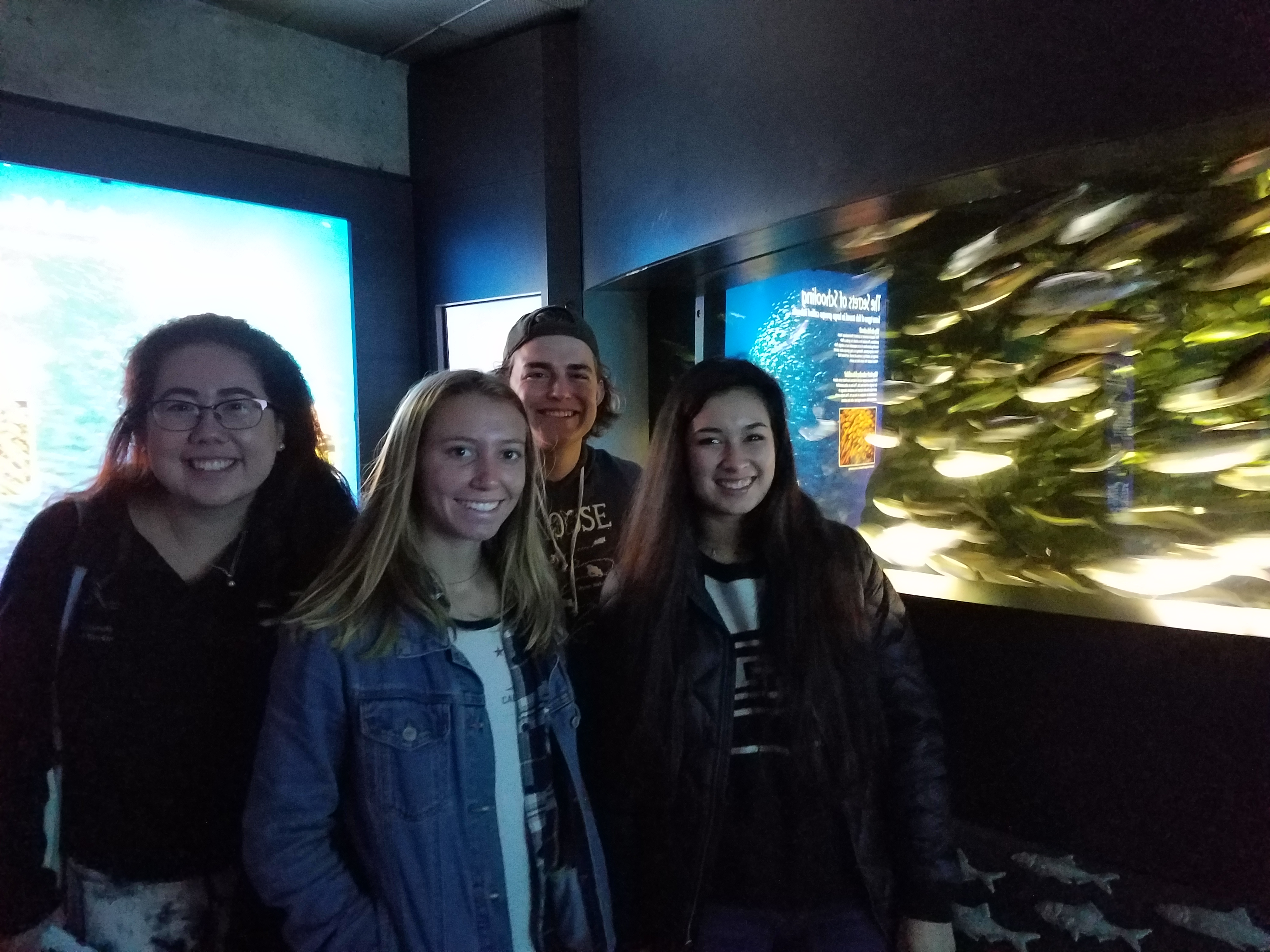
Students standing next to the herring treadmill exhibit.
Jessica Chen
According to its website, “the New England Aquarium (NEAq) is home to thousands of aquatic animals.” Pictures of charismatic megafauna are plastered everywhere, from penguins, to sharks, to lionfish. The aquarium, just like the documentaries we watched in class, are trying to use these popular animals to appeal to consumers and viewers.
Lionfish are fascinating to the public and bring a lot of tourist attraction. That’s why they’re sometimes seen as a benefit to tourism in Atlantic coral reefs, even though they’re actually invasive. Though the specific vector is unknown for how lionfish got into the Atlantic, often invasive species are introduced as a byproduct of aquarium trade. Aquarium trade doesn’t only refer to big aquariums like the NEAq, but refers to the import of all types of marine species for home aquariums as well, and it’s suspected that lionfish may have been dumped in the Atlantic after it pet owners no longer wanted them.
Furthermore, according to Ocean: the Definitive Visual Guide, often times in Southeast Asia, sodium cyanide is used to immobilize reef fish to make them easier to catch for aquarium trade, but ends up poisoning the coral it comes in contact with (Cousteau 2014). While it’s not known whether the NEAq supports merchants who use this practice, it’s a common threat to coral ecosystems globally.
Furthermore, the captivity of carnivorous species in some of the NEAq’s exhibits makes one wonder how they’re being fed. It draws similarities to the “Tigers of the Sea” in aquaculture, in which smaller, wild fish are caught to feed the bigger fish in farms, and thus making the farming of these “Tigers” unsustainable. The NEAq is home to carnivores such as penguins, sharks, octopus, and seals, and this begs the question of how sustainable the NEAq exhibits are for wild fish stocks.
The New England Aquarium has been running for about 50 years out of Boston. They have a variety of exhibits of marine life from all over the globe, sea lions and seals, multiple touch tanks, and a multi-level tower in the middle of the aquarium for visitors to see life at different depths (“About Us” n.d.). However, as we learned in most of our documentaries, not all is as it seems.
One of the first comments Professor Webster made when our class experienced the touch tanks was that most of the habitat was man-made. It is already difficult to contain animals that to also add the upkeep of aquatic plants would be almost impossible. Furthermore, there is no real way keepers could keep the animals from destroying a natural marine habitat; Florida shared that at her home-town aquarium, sea lions were not given real kelp because they would rip it up instantly.
As I continued to go through the aquarium, I saw numerous other ethical dilemmas. A lot of the tanks looked too small for their inhabitants. Some had posters explaining that they prefer a small ecosystem because they are “territorial,” but I doubt a wild grouper would never move more than 15 square feet in its life. Secondly, the touch tanks seemed extremely invasive and stressful to the animals. Even though the aquarium tried to brand the seal training as enriching and good for the animals, the training and their bare habitat did not seem natural. Aquarium regulation is minimal, and there are 126 government inspectors responsible for monitoring 10,433 facilities every year (“Aquariums and Marine Parks” n.d.). It is hard to say if New England Aquarium is not responsibly caring for their animals, but more government regulation and inspection should be instituted so that people have – at the least – more data to make a decision.
Kyle Sullivan
The New England Aquarium provides a contradiction between conservation and the problems inherent to holding wild animals in captivity. The aquarium is devoted to environmental awareness and protection, and the animals are monitored, specifically fed, and rehabilitated when necessary. But, while watching the school of herring swim around in constant circles, issues with the morality of aquariums struck me. These animals, especially those that were not saved from injury, are taken out of their natural habitats and placed into filtered Boston Harbor water in order to satisfy the curiosity of thousands of people every day. There are certainly issues that need to be discussed with this treatment. The herring generally seemed healthy, but there were quite a few notable exceptions. Some fish were completely crippled, and bent in the shape of Z’s, while others had large growths on their bodies. While there are certainly unhealthy fish in the ocean, weak individuals contribute to the overall ecosystem; they are the first to be eaten, and their reduced fitness means their genes are removed. Unhealthy fish in the herring tank are on display with their healthier school members. Moreover, some animals were being harmed by their captivity, which was obvious in the ray touch tank, where many individuals had bloodied noses due to their clear enclosure. But, the aquarium itself is an outspoken and committed advocate for saving the oceans from overfishing, global warming, and other threats. It is also important to note how much the aquarium is committing to conservation and activism versus overall profits. The issue is multi-faceted; ostensible environmentalism can certainly increase notoriety and profits. I think the real question is whether or not sacrificing some individuals into lives of captivity can spread knowledge, awareness, and enthusiasm enough to make the benefit outweigh the costs.

Sharks hanging out in the touch-tank exhibit.

